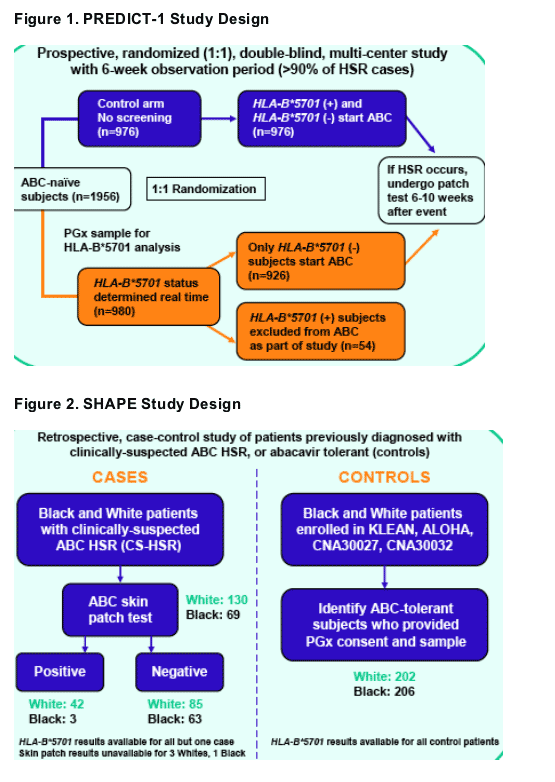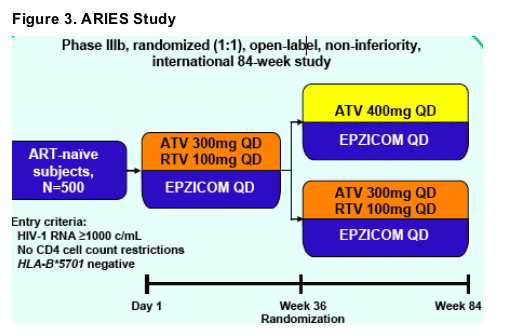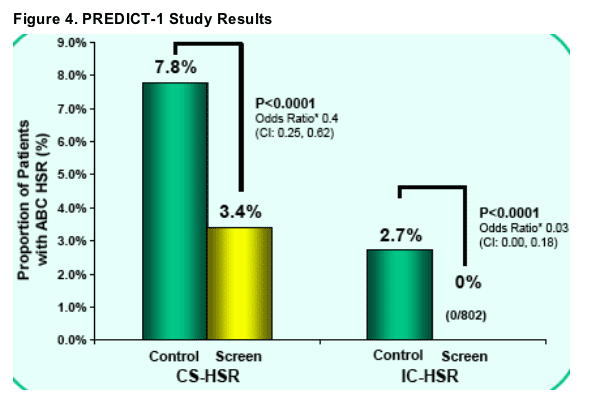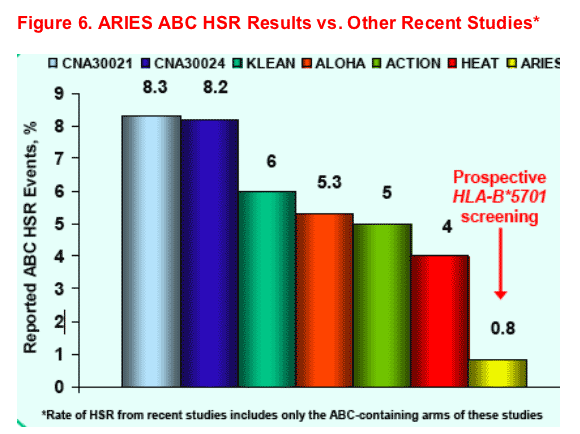 |
 |
 |
| |
HLA-B*5701 Screening Reduces Abacavir Hypersensitivity Reactions (ABC HSR); Multiple Lines of Evidence to Establish a New Standard of Care
|
| |
| |
Reported by Jules Levin
IAC Mexico City Aug 3-8, 2008
Wannamaker P1, Mallal S2, Phillips E2, Young B3, Brothers C1, Sutherland-Phillips D1, Thorborn D4, and Shaefer M1
1GlaxoSmithKline Research and Development, Research Triangle Park, NC, USA; 2Murdoch University, Perth, Australia;
3Denver ID Associates, Denver, CO, USA; 4GlaxoSmithKline Pharma Europe, Brentford, UK
AUTHOR DISCUSSION
The PREDICT-1 study used a robust, randomized, prospective double-blinded study design to substantiate the clinical benefit of HLA-B*5701 screening to reduce ABC HSR events in a predominantly white population; however, its blinded study design precluded the ability to directly realize the impact that
prospective knowledge of HLA-B*5701 status has on reduction in false positive clinical diagnosis.
The SHAPE study, using a case-control design, demonstrated the high sensitivity of HLA-B*5701 for ABC HSR to be generalizable across White and Black racial groups, representing the major target populations with the highest and lowest allele frequencies, respectively, and supporting generalizability of the utility of HLA-B*5701 screening across race.
In a large and diverse US population, the ongoing ARIES study resulted in a dramatic reduction in ABC HSR rates compared to similar historical studies.
-- The results from ARIES are fully consistent with both the PREDICT-1 and SHAPE studies, as well as multiple independent open screening cohorts, demonstrating a marked reduction in all suspected ABC HSR events, none of which were confirmed by ABC skin patch testing.
-- The open-label design of the ARIES study is a further evolution of the HLA-B-5701 screening concept which reflects clinical practice, where a diverse ABC-naive population was treated prospectively and screening result were known both by patients and prescribers.
This pharmacogenetics research program, from the initial identification of the association of HLA-B*5701 with risk of ABC HSR, independent replication of the association, and demonstration of the clinical utility of HLA-B*5701 screening on patient safety, provides a model for other researchers toward the incorporation of PGx and other biomarkers into clinical practice.
AUTHOR CONCLUSIONS
Screening for HLA-B*5701 and avoidance of ABC in those who are positive for the allele reduces the risk of abacavir hypersensitivity reaction.
-- The PREDICT-1, SHAPE and ARIES studies provide the evidence of validity, generalizability and effectiveness to establish screening as a standard of care approach where available.
While HLA-B*5701 screening is an effective tool to reduce ABC HSR, appropriate clinical management of suspected HSR remains critical.
ABSTRACT
Background: ABC HSR has been associated with the pharmacogenetic marker HLA-B*5701 in several studies. However, evidence of the clinical utility of screening is required from controlled clinical trials, open screening programs and from different target populations to justify uptake into clinical practice.
Methods: PREDICT-1 was a prospective, randomized, controlled, double-blinded
study enrolling European and Australian subjects to compare the incidence of ABC HSR with or without prospective HLA-B*5701 screening. SHAPE was a retrospective case-control study to estimate the sensitivity of HLA-B*5701 in Black and White subjects in the United States with ABC HSR. ARIES is a prospective treatment simplification study of ABC/3TC + atazanavir/ritonavir in HLA-B*5701 negative ART-naive subjects across the United States and Canada. Skin patch testing (SPT) was used to provide immunologic confirmation of suspected ABC HSR in all studies.
Results:
In the predominantly white population enrolled in PREDICT-1, 5.6% of
subjects carried HLA-B*5701. SPT-positive cases of ABC HSR were reduced from 2.7% to 0% in the screening arm (7.8% to 3.4%, all cases) (p<0.001).
SHAPE demonstrated a 100% sensitivity of HLA-B*5701 for SPT-positive ABC
HSR in both White (n=42) and Black (n=5) subjects.
In ARIES, which employed prospective HLA-B*5701 screening, 725 ART-naive subjects were screened of which 32 (7.2%) of Whites and 7 (2.8%) Blacks were positive for HLA-B*5701 and excluded. After open screening and initiation of ABC, suspected HSR was reported in 4 subjects (0.8%) through 18 weeks, none were SPT-positive.
Conclusions: Results from PREDICT-1, SHAPE and ARIES provide conclusive
evidence of the validity, generalizability and effectiveness of HLA-B*5701
screening as a standard of care approach before starting an abacavir
containing regimen. Although screening dramatically reduces the risk of ABC
HSR, appropriate clinical management of suspected HSR remains paramount.
INTRODUCTION
Research into the genetic basis of the abacavir hypersensitivity reaction has identified a strong association between the HLA-B*5701 allele and clinical abacavir hypersensitivity.1, 2
The use of an abacavir skin-patch test has helped to improve the diagnostic
precision of ABC HSR in research settings.3
An immunogenetic basis for HLA-B*5701-restricted ABC HSR has been
identified, further strengthening this correlation.4
Given the strong relationship of this pharmacogenetic marker for ABC HSR
and the widespread availability of this test, the clinical utility of this marker
can be demonstrated through several lines of research, including:
- Results from a large, prospective, blinded, randomized study demonstrating significant benefits in risk reduction for developing ABC HSR with the use of HLA-B*5701 screening.
- Compelling data suggesting the generalizability of screening across diverse populations.
- Large prospective open screening studies consistently demonstrating significant reduction in rates of suspected ABC HSR post-screening.
-- Results from "real-world" populations demonstrating efficient and effective screening practices.
METHODS
GSK undertook three studies to address the clinical utility of HLA-B*5701 screening to reduce the incidence of ABC HSR. Study designs are below:


RESULTS
The PREDICT-1 study demonstrated a statistically significant reduction in the incidence of clinically-suspected ABC HSR (CS-HSR) after exclusion of subjects who carried HLA-B*5701, and none of these subjects had immunologically confirmed ABC HSR (IC-HSR) by skin patch testing (Figure 4).5

The SHAPE study demonstrated a high (100%) sensitivity of HLA-B*5701 in both
White and Black subjects who had an ABC HSR that was immunologically confirmed by a positive ABC skin patch test. Specificity of HLA-B*5701 in a
group of ABC-tolerant white and black controls was 96% and 99%, respectively
(Figure 5).6

In ARIES, 725 subjects were screened for entry; 41 (5.7%) were found to be HLA-B*5701 positive and were excluded. These included 32 (7.2%) Whites, 7 (2.8%) Black and 2 (5.6%) Other (American Indian [1], Asian [1]) race. The ARIES study demonstrated that in a diverse US population (34% Black), suspected ABC HSR was rarely reported (4/ 517, 0.8%) after open-label HLA-B*5701 screening through 36 weeks, and that none of these cases were immunologically-confirmed by ABC skin patch test. This result is dramatically lower than recent similar studies where HLA-B*5701 screening was not used. (Figure 6).7

Independent cohorts in France, Australia and the UK have also reported similar reductions in the rate of suspected ABC HSR after initiation of an HLA-B*5701 screening program prior to initiation of abacavir therapy.8, 9, 10
REFERENCES
1Mallal S, Nolan D, Witt C, et. al. Association between presence of HLA-B*5701, HLA-DR7, and HLADQ3 and hypersensitivity of HIV-1 reverse transcriptase inhibitor abacavir. Lancet 2002; 359:727-732.
2Hetherington S, Hughes A, Mosteller M, et. al. Genetic variations in HLA-B region and hypersensitivity reactions to abacavir. Lancet 2002; 359:1121-1122.
3Philllips E, Sulivan J, Knowles S, et. al. Utility of patch testing in patients with hypersensitivity syndromes associated with abacavir. AIDS 2002; 16:2223-2225.
4Chessman D, Kostenko L, Lethborg T, et. al. Human leukocyte antigen class 1-restricted activation of CD8+ T cells provides the immunogenetic basis of a systemic drug hypersensitivity. Immunity 2008; 28:822-832.
5Mallal S, Phillips E, Carosi G, et. al. HLA-B*5701 screening for hypersensitivity to abacavir. N Engl. J. Med. 2008; 358:568-579.
6Saag M, Balu R, Phillips E, et. al. High sensitivity of human leukocyte antigen-B*5701 as a marker for immunologically confirmed abacavir hypersensitivity in white and black patients. CID 2008;46: 1111-1118.
7Young B, Squires K, Patel P, et al. First large, multicenter, open-label study utilizing HLA-B*5701 screening for abacavir hypersensitivity in North America. AIDS, 2008; In Press.
8Zucman D, de Truchis, P, Majerholc C, et al. Prospective screening for human leukocyte antigen-B*5701 avoids abacavir hypersensitivity reaction in the ethnically mixed french HIV population. J Acquir Immune Defic Syndr 2007;45:1-3.
9Rauch A, Nolan D, Martin E, et al. Prospective genetic screening decreases the incidence of abacavir hypersensitivity reactions in the Western Australian HIV cohort study. CID 2006;43:99-102.
10Waters L, Mandalia S, Gazzard B, et. al. Prospective HLA-B*5701 screening and abacavir hypersensitivity: a single centre experience. AIDS 2007;21:2533-2534.
|
| |
|
 |
 |
|
|